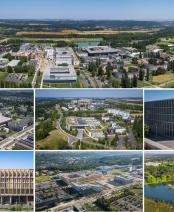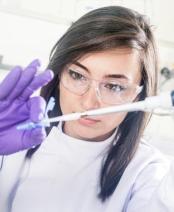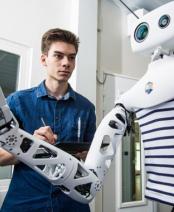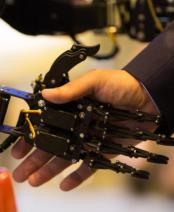Interview with Dominique Fontaine, astrophysics researcher

Dominique, it’s been 60 years since the first manned space flight, many achievements and multiple discoveries have been made in the space field. You are an expert in space plasmas, could you explain the link between plasma science and space exploration?
The understanding of plasmas, an ionic form of gases, considered in physics as the fourth state of matter, is essential for space exploration because today it is recognized that 99% of all observable matter in the universe is in the plasma state. When we move away from the surface of the Earth, the density of the Earth's atmosphere decreases with altitude, and after a while we enter the ionosphere, composed of ionized particles. The ionosphere is the first plasma found in the upper layers of the Earth's atmosphere. The Sun is also a gigantic ball of plasma. Then, if we take our Solar System, apart from the planets and their possible atmospheres, all that interplanetary space is plasma.
How is it possible to study such distant phenomena that occur in space, thousands or even millions of kilometers away?
In our Solar System, we use satellites that collect in situ data (in situ means in their natural environment) to explore plasmas in the environment of planets, plasmas from the Sun and plasmas in interplanetary space. They are equipped with radiation detectors, particle analyzers, electric and magnetic field sensors.
However, it is necessary to be very patient to get out of the Solar System, because it takes 40 years to get out of it, with the current propulsion technologies. There are only two interstellar probes, Voyager 1 and Voyager 2, launched in 1977 and 1978, that crossed the boundary of our Solar System, but their signals are getting weaker because of the distance. We will lose them, but the Voyagers will continue their lives ad vitam aeternam.
To explore more distant space, we use indirect techniques, that means we do not analyze plasmas in situ, but lights at different wavelengths, emitted by the various objects or during an event (collision of particles etc.). We measure a radiation observable on Earth, and from there we try to imagine its origin, the constituents, the mechanisms. These lights are collected either by ground-based telescopes or by orbiting telescopes.
In addition, scientists make numerical simulations that allow us to imagine phenomena that are happening in the universe. Others do experiments in the laboratory that attempt to reproduce approximately the conditions in space. But all build models that must match with the in situ observations.
What are the uses of artificial intelligence in your field?
Astrophysics, like many other disciplines, is in the era of big-data. AI has become a ubiquitous technology today; our field is no exception. Our first satellites did not have very sophisticated instruments on board, such as very fast calculators, and could not transmit much information. Now they can send a colossal amount of data, the processing is done partly on board, the received data is very detailed and high-quality data.
For about 20 years, we have had large amounts of data, stored in huge data centers, on the plasmas from the Sun, around Earth and in the interplanetary medium. Artificial intelligence allows us to extract and interpret the data we need. To develop algorithms, astrophysicists work hand in hand with mathematicians who know these methods. And the volume of data will probably grow further in the future!
Indeed, the progress in space is spectacular, compared to the 1960s.
I think it was an impressive period. The rivalry between the USSR and the USA in the context of the Cold War generated a very powerful motivation.
It is absolutely incredible how the Soviets managed to put the first man into space and how the Americans managed to send men to the Moon. These missions were prepared in such a short time! We weren't completely sure that the astronauts would come back from their missions. I don't know if these days we would be able to be so bold.
Furthermore, at that time, it was not yet known that solar storms existed and that there could be very harmful radiations in interplanetary space. Miraculously there was no solar storm when the men walked on the Moon, otherwise they could have been irradiated and the spacecraft's equipment would probably have been affected. What a chance!
It may be noted that the confrontation between the Soviet Union and the United States has greatly contributed to the development of space programs. For example, NASA (National Aeronautics and Space Administration) was created during that period, in 1958, to manage space projects, previously managed by US Air Forces, to catch up with the Soviets who were ahead of America in the Space Race.
After the fall of the Berlin Wall, the situation changed. The conquest of space still represents very important issues (scientific, technical, economic and political) but it is much more collaborative.
Clearly, we see that today researchers from all over the world collaborate, meet at international conferences, present their results...This was not common practice during the Cold War.
Absolutely, there is strong international cooperation and everything is organized on a global scale. Several countries have space agencies, such as CNES in France, ESA in Europe, NASA in the USA, ROSCOSMOS in Russia, JAXA in Japan, CNSA in China, ISRO in India, etc.
When the cost is very high, the space agencies cooperate. For example, two years ago, ESA and JAXA launched together the BepiColombo probe to Mercury.
Note that in the space field, the strategy is worked out a long time in advance, for example, today we are still in ESA's "Cosmic Vision 2015-2025" programme, but we are already working on the strategy of the next programme "Voyage 2050".
Which missions is your Laboratory of Plasma Physics currently involved in?
For example, we are participating in the BepiColombo mission that I just mentioned. It is a probe sent in 2018 to observe the planet Mercury, the closest to the Sun. It will arrive in 2025. The LPP is responsible for two instruments.
The probe is controlled by teams from the European and Japanese space agencies, ESA and JAXA. The LPP team will receive data from its instruments. This mission has technical challenges to face. In order to be able getting into orbit around Mercury the satellite follows a very complex trajectory and uses the gravitational assistance of the Earth, Venus and Mercury. In addition, the probe will be exposed to temperatures between – 190°C et +420°C.
How long will this probe remain in orbit around Mercury?
Two years, and if all goes well, we will ask for an extension.
Currently, we are also participating in the ESA’s Solar Orbiter, a satellite mission to explore the inner regions of the Solar System, launched in 2020. In 2023-2024 it will be very close to the Sun, at a distance of 42 million km, closer than the orbit of Mercury! Imagers will help us make the connection between events on the Sun's surface (eruptions, mass ejection, etc.) and their propagation in space, the probe will measure in situ characteristics.
Finally, we have just finished a magnetometer that will depart for Jupiter in 2022, with the ESA’s JUICE mission. The probe will arrive at its destination in 2030 and we will be able to make observations until 2033.
So, the Laboratory of Plasma Physics is working a lot on instruments for missions?
Yes, here at the LPP, we have experience, real know-how in the manufacture of instruments to measure waves and particles. To propose a new instrument, we base on those we have already created, launched. However, they are always unique models, because we have to adapt them to different environments. For example, the Mercury environment is very different from that of Jupiter (particles, frequencies, etc.).
How long does it take to make a scientific instrument?
It takes about ten years to design the mission, to design the instrument, then a prototype, and finally the flight instrument. This requires a lot of testing. It is important to check if the instruments are resistant to vibrations and shocks, as they are strongly shaken during launch. Thermal tests are also carried out, placing the instruments in vacuum pans and observing their operation at extreme temperatures, very cold and very hot. We also test the resistance of instruments to radiation because certain environments, for example that of Jupiter and around the Sun, are very radiative. These tests are carried out on testing platforms reserved for scientists.
How do you define the duration of the mission?
We need to estimate the duration of the instruments in space. They have some parts more sensitive than others, especially to radiations. However, sometimes the instruments work longer than expected. So, I worked on ESA's CLUSTER mission, launched in 2000, aimed to explore the Earth's magnetic environment. The nominal lifetime was 2 years. However, it is still in the air, it's been more than 20 years! The instruments are still functioning. Each time we needed to request an additional financial support to continue the mission and to continue recording data.
A satellite tracking also requires ground crews. Engineers are needed to send instructions to the instruments (telecoms) to trigger the different "modes" of operation and to receive the data packets (tele measures) from these instruments. Then, you also need teams to analyze that data.
You have been working in this field for a long time, have you noticed a fluctuation in interest in astrophysics over the years? Are young people still interested in astrophysics and plasma physics?
Certainly, since the first flight of man into space many things have changed. Before all the children wanted to become astronauts, today it is less the case. I would say that access to space has since become commonplace. It's no longer extraordinary to launch a rocket, it's no longer surprising to send a satellite into space...
On the other hand, I note that interest in astrophysics has not diminished, space and the universe still interest young people. Today's young people pay a careful attention to ecology, to protecting the planet, to treating waste and to better understanding of life. For example, they are very interested in new challenges in space: the management of space debris.
There are currently more than 130 million pieces of debris orbiting the Earth. They can be tiny, less than a millimeter, but also as bulky as a bus. The people have nothing to fear, the debris is at altitudes above several hundred or thousands of kilometers from our planet and will burn up as they enter the Earth's atmosphere. However, these flying objects, given their quantity and high speed, become very dangerous for new satellites, presenting collision risk and damage. That's a real source of concern! We need to think about how to clean up and how to avoid polluting. And young people are right to care about this as of now!













